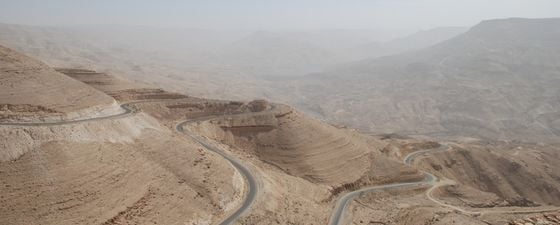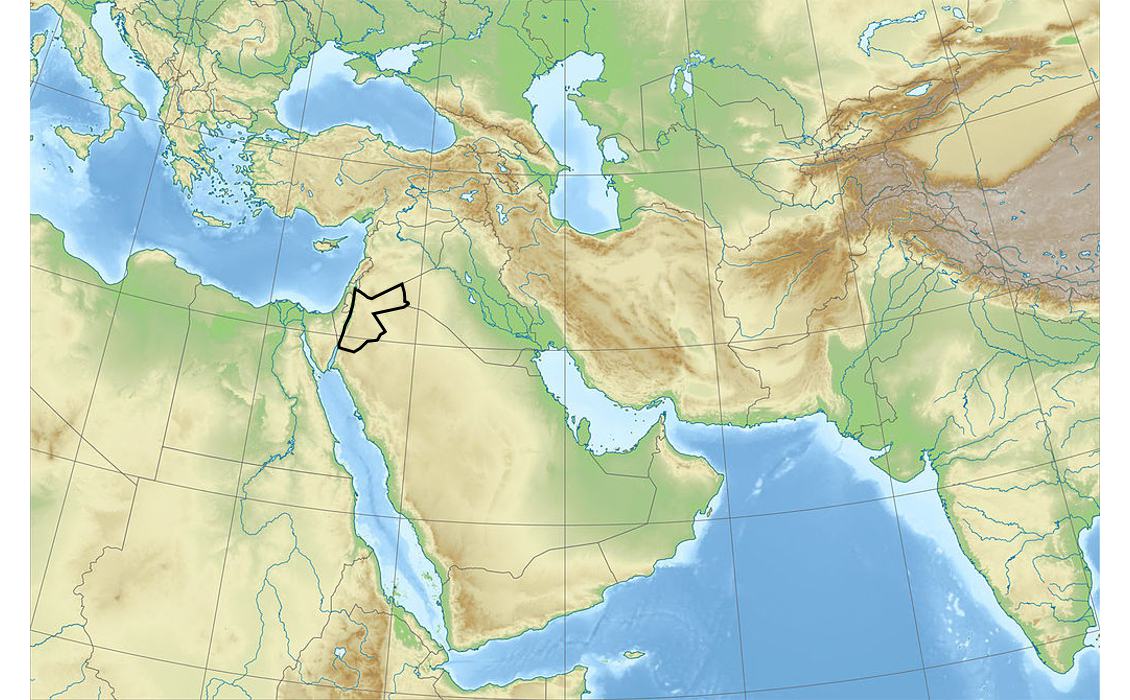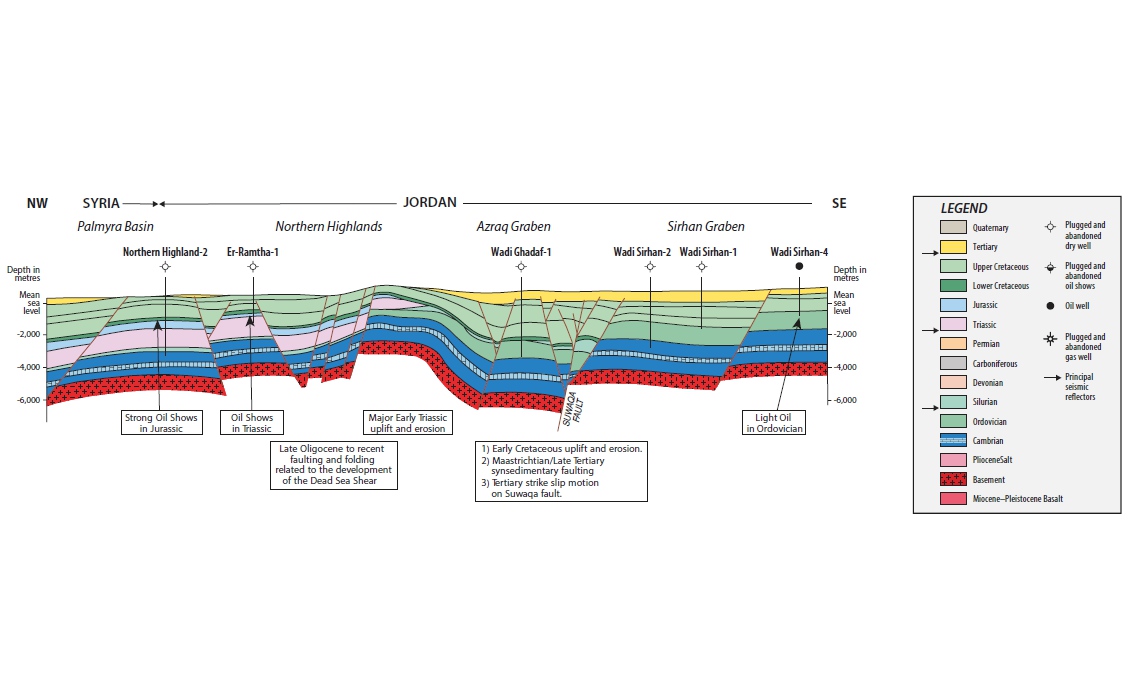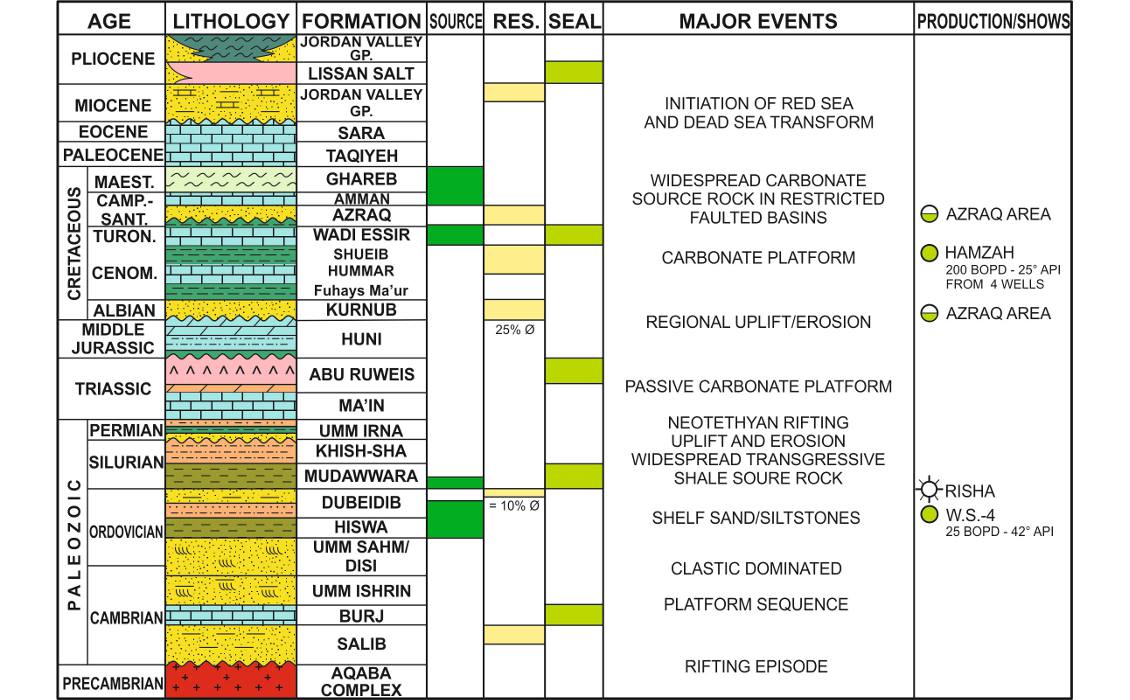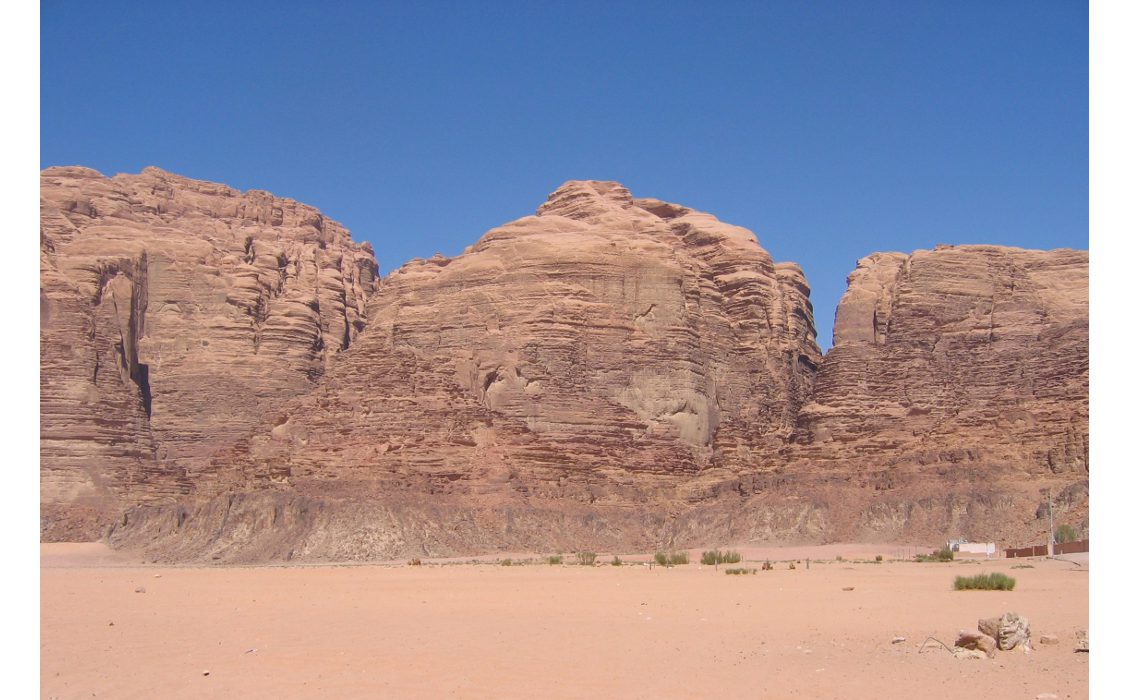Regional geology and tectonic history
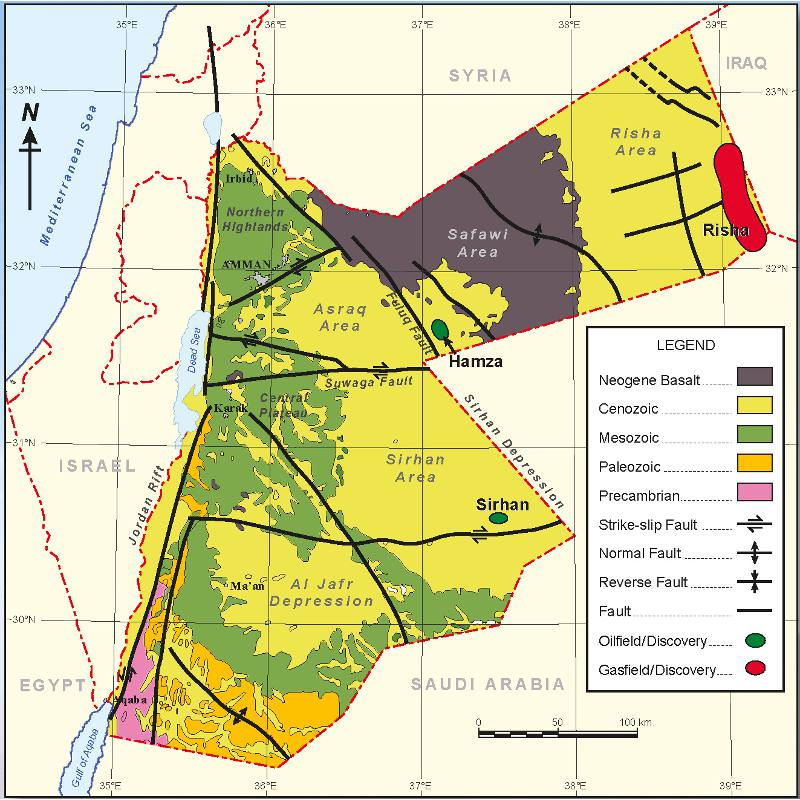
Jordan occupies the north-western Arabian Plate, with most of the country located within the shelf part of the plate. Precambrian basement is exposed along the edge of the Arabian Shield in southern Jordan and northern Saudi Arabia and consists of accreted micro continental terranes, overlain by post-tectonic sediments and volcanics.
Extensional, rift-related tectonics dominated the area during late Pre-Cambrian to early Cambrian periods. The Najd Fault System which originated during this time has resulted in the formation of large depressions that were subsequently filled with Palaeozoic clastics.
Passive margin conditions with periods of transgression and regression dominated the area during the Early Palaeozoic, whereas active tectonic movements of deep erosions were dominant in Late Palaeozoic periods. Upper Ordovician glacio-fluvial sandstones and Lower Silurian organic-rich shales were among the most important sediments deposited in this period (Figure 1).
Most of the Palaeozoic basins in Jordan are compartmentalised by Cretaceous-Tertiary wrench faults related to Late Cretaceous fragmentation of the Arabian Plate. During the Permo-Triassic, extensional tectonics rifted the Arabian Plate from the Turkish-Iranian Gondwanan fragments. Mesozoic-Cenozoic basins in Jordan such as Azraq-Sirhan are dominantly rift-related.
A mid-Tertiary tectonic phase resulted in the opening of the Red Sea and the development of the Dead Sea–Wadi Araba Graben and the Arabian Plate boundary.
Four petroleum systems have been identified in Jordan. Two are within the Infra-Cambrian–Lower Palaeozoic sequences, one within the Triassic-Jurassic sequence and one within the Cretaceous-Tertiary sequence (Figures 2 and 3).
Infra-Cambrian–Cambrian petroleum system
This system is semi-proven in the Tabuk Basin of northern Saudi Arabia (Kahf field) and is of potential in the Jafr Basin of south-central Jordan. The lack of other discoveries can be attributed to the poor understanding of the system, as well as the relative immaturity of the Infra-Cambrian–Cambrian source rocks and the lack of oil extract to source correlation. The shale of the Infra-Cambrian Saramouj Group and the Cambrian Salib Formation are lacustrine in origin while the carbonates of the overlying Burj Formation are marine. No data are available on the quality of the organic matter and its maturity. In northern Saudi Arabia, however, an Infra-Cambrian–Cambrian source has been postulated for the oils in the Ordovician Sarah Formation reservoir.
The basin architecture in Jordan is characterised by series of asymmetrical half-grabens. Structural highs are step-faulted, uplifted margins of rotated basement blocks. Structural lows are the broad sags of syn-rift infill at the down-faulted margins of the listric fault-bounded basement blocks, as seen in Figure 2. The timing of structural development of the main rift is postulated to be in the Middle to Late Early Cambrian.
The primary reservoir is the porous arkosic sandstone of the pre-rift Salib Formation, sourced from down-dip syn-rift shales or from the limestone and shale of the Middle Cambrian Burj Formation.
Apart from the Kahf field in northern Saudi Arabia, there are no other wells to prove this system. This is an area for future exploration work in the South Jordan Block.
Ordovician-Silurian petroleum systems
The Ordovician-Silurian system in Jordan is part of the Tabuk-Nafud Basin covering northern Saudi Arabia and the Rutbah High in western Iraq. It is proven in the Risha gas field in north-east Jordan, and the Sirhan 4 light oil discovery in south-east Jordan, at the Akkas oil, gas and condensate field, western Iraq and most recently, the Jalamid gas discovery in northern Saudi Arabia.
There are several horizons with source rock potential within the Ordovician and Silurian sequence in Jordan. The shale units of the Ordovician Hiswa and Dubaidib Formations, below the Risha Sandstone Member, are indicated by several independent geothermal studies to be over-mature source for the dry gas in the Risha sandstone reservoir in the Risha field, and may have contributed gas to the Sirhan 4 discovery. The Silurian hot shales are proven to be in the oil window, both in the Risha and Sirhan areas.
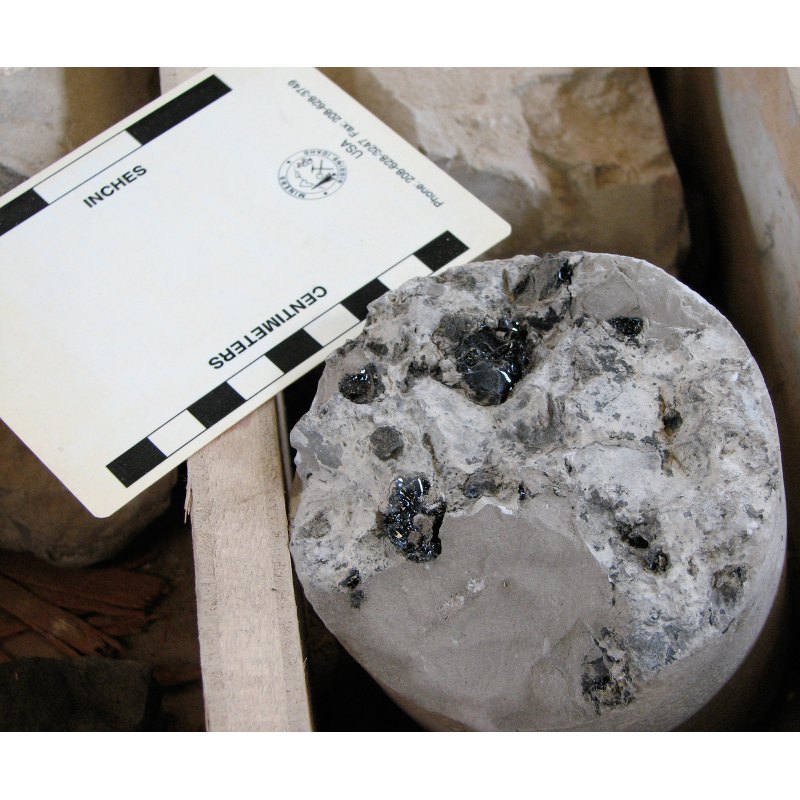
The play target is the Ordovician sandstone reservoir in the Dubaidib Formation upper sandstone section, the Risha Sandstone Member in the Risha gas field and its equivalent in several Sirhan wells in south-east Jordan. Prospective traps in the Risha High are low relief anticlines and stratigraphic traps at top Ordovician level, while in the Sirhan area traps are found in numerous roll-overs, horsts and fault blocks. The Triassic carbonate reservoir in north-east Jordan could also be considered a stratigraphic oil play sourced from the Silurian shale. Upper Cretaceous carbonate core was recovered with cavities filled with asphalt oil, shown through geochemical analysis to be Palaeozoic oil (Figure 4).
The base Silurian shale is a proven regional seal for the underlying Ordovician reservoirs, both in the Risha and Sirhan areas. However, for individual sandstone reservoirs, which are interbedded with shales within the Ordovician succession, the shale units are local seals (Figures 2 and 3).
Triassic petroleum system
This system is proven in oil and gas fields such as the Cheriffe field in the Palmyra area of central Syria. It is very prospective in northern Jordan, where the equivalent of the Syrian Kurra Chine carbonates, evaporates and shales are present. The organic rich layers within the Syrian Triassic Amanus Shale and Kurra Chine formations are similar in composition, consisting of fine-grained limestone and dense calcareous shale, and these sediments are also present in northern Jordan, where oil generation is proved by the existence of oil seeps associated with spring waters flanking the Ajlun Dome. Live oil shows were also observed in a core from the Jurassic limestone obtained from the NH-2 well near the southern Syrian border (Figure 2).
The Triassic and Jurassic carbonates and evaporates are ideal reservoir and seal alternations, with the carbonate reservoirs exhibiting porosities of up to 20% in places. These are interbedded with anhydrites, which form an effective seal. The regional northwards plunge is interrupted by horst blocks, step faults, anticlinal structures and marginal swells. In the East and West Safawi areas in northern Jordan, the plays are mostly in graben-associated structures and stratigraphic pinch-outs. One major stratigraphic anomaly in the Upper Triassic carbonates, presumably associated with reefal build-up, is recognised in the northern part of the Safawi Block which require testing by drilling.
Cretaceous-Tertiary petroleum system
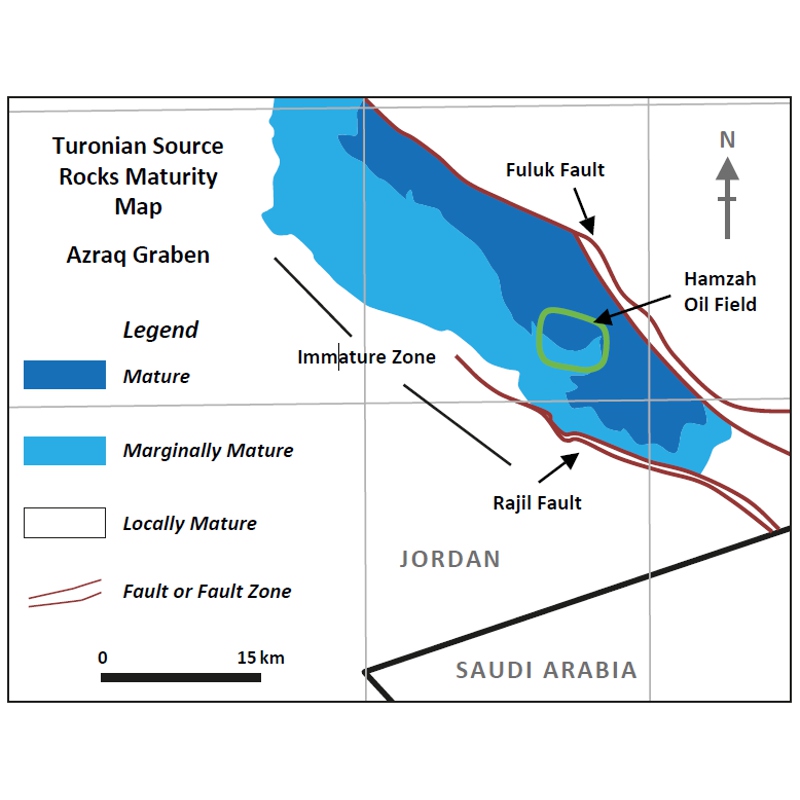
This system is proven in the Azraq Graben, which is located in central Jordan. It is an asymmetrical graben with significant thickening of the Cretaceous and Paleogene sediments, bounded in the east by the north-west to south-east trending Fuluk fault. The area was the site of early exploration drilling activity, where the only producing Jordanian oil field, Hamzah, is located. Source rocks are the interbedded Cenomanian and Turonian Wadi EsSir limestones and marl. All the drilled wells in the Azraq Graben have penetrated the Maastrichtian Ghareb oil shale formation at shallow depths.
In addition to the proven oil accumulation in the downthrown side of the Fuluk fault, there are shallow prospects on the upthrown block, where the structural style is one of rotated fault blocks. Source rocks in the downthrown side of the graben are exothermally mature for oil (Figure 5).
Subsequent to the first oil discovery at Hamzah-1, sixteen wells were drilled in the area, including appraisal and production wells, with another thirteen wells drilled elsewhere in the graben. Several wells produced non-commercial reservoir oil, and others found non-conventional oil from Wadi EsSir source rock formation.
A series of compressional anticlines are found on the downthrown side of the southern east-west boundary fault of the Azraq Graben, the Suwaqa Fault. These anticlines trend in an east-west direction. Several high-level closed anticlines have been mapped at the western up-dip margin of the Azraq Graben, and they represent good targets at shallow depths, since they lie on possible migration pathways from deep basinal areas (Figures 2 and 3). The source rock Wadi EsSir Formation is also the effective seal for oil accumulations in the Azraq Graben.
In the Dead Sea Graben, the organically rich Upper Cretaceous Ghareb shales and marls are known from both sides of the rift, and have widespread distribution over most of Jordan. Unlike the near-surface positions they hold on the basin margins, these source rocks are thrown into the rift to depths of more than 5,000m. At this depth the source rocks reached the oil window, and the generated hydrocarbons migrated upward and onward to supply traps and seeps on the Jordanian side of the graben. The issue in the Dead Sea area is not source, but the apparent lack of good reservoir rocks, as well as the mobility of salt in the centre of the basin, which prevents wells reaching the Palaeozoic, Triassic, Cretaceous and Tertiary reservoirs.
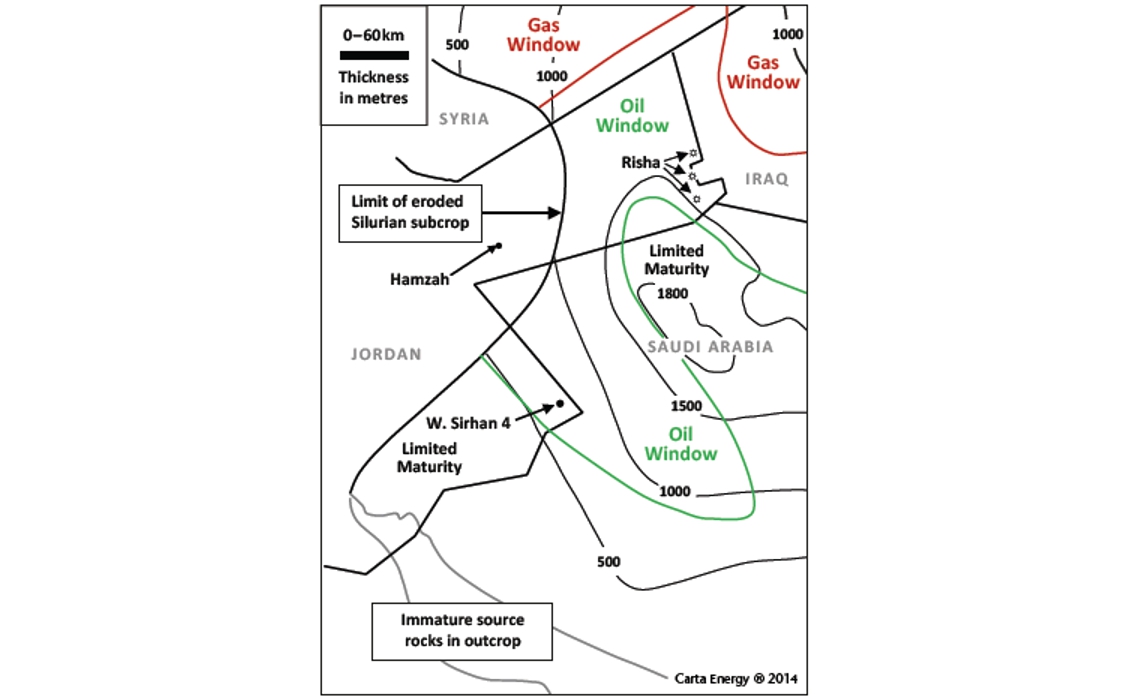
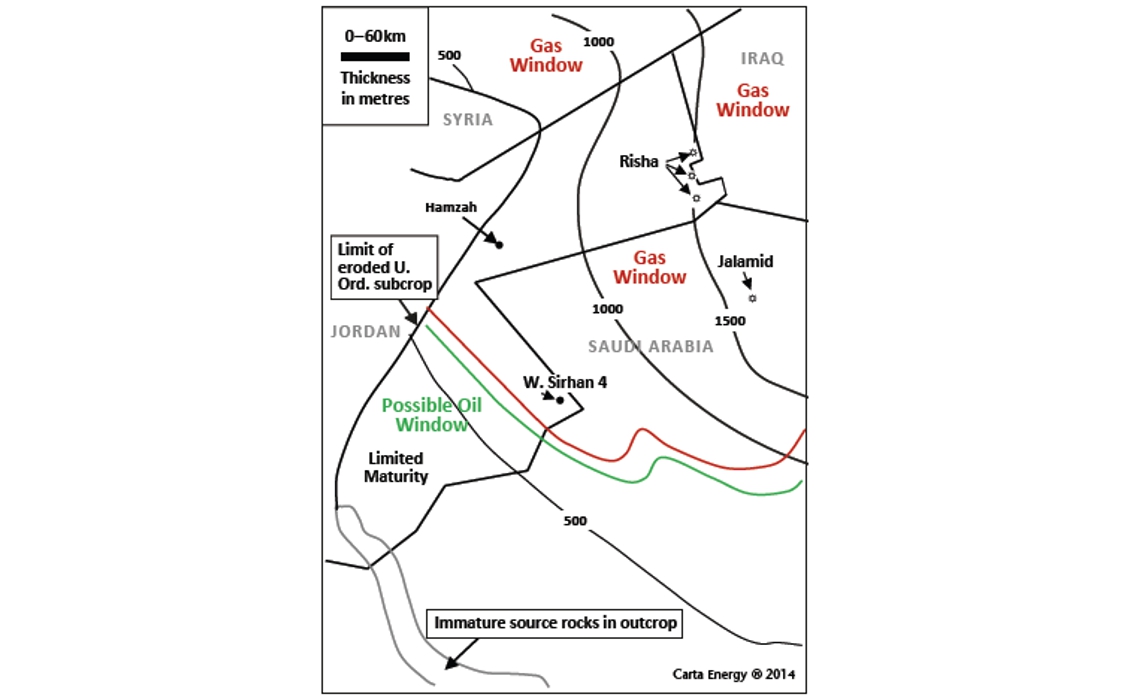
Oil shale, shale oil and shale gas potential
The paucity of adequate structures may explain the lack of many discoveries in Jordan. However, recent investigations have shown the presence of huge oil shale reserves in the exposed immature Upper Cretaceous Ghareb source rocks. Some international oil companies already have licences for the exploitation of the oil shale in Jordan.
Silurian shale oil is another widely distributed source rock in Jordan, both in the ‘panhandle’ east of Jordan, including the Risha and Safawi areas, and in the Sirhan area, south-east Jordan (Figure 6). Ordovician shale gas is also found in the widely distributed source rocks in eastern and south-east Jordan (Figure 7). This promising unconventional potential should see the acceleration of high-tech hydrocarbon exploration activities in Jordan.
References
Naylor, D., Al-Rawi, M., Clayton, M., Fitzpatrick, M.J., and Green, P.F., 2013. Hydrocarbon Potential of Jordan. J.P.G., Vol. 36 (3), July 2013, pp. 205-236.
Natural Resources Authority (NRA), 1997, 2000, 2001 and 2004. Petroleum Exploration Opportunities in Jordan. Amman, Jordan.

